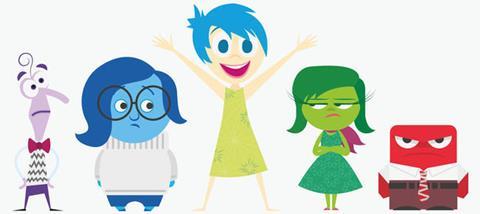
Yes. Obviously. We work with young people; we spend our whole time trying to figure out what is going on inside their heads, and most of that time failing.
Disney and Pixar’s latest team-up is a film about emotions. While the plot, nominally, is about 11 year-old Riley adjusting to a new life in San Francisco, the real action of Inside Out happens inside her mind. Her brain is inhabited by five emotions: the green opinionated ‘Disgust’, the red and liable to explode at any minute ‘Anger’, the teeny purple ‘Fear,’ the blue mopey ‘Sadness’ and Joy, the self-appointed leader of the group who looks weirdly similar to Tinker Bell and has made it her mission in life to ensure Riley is happy at all times. These emotions are one of the three central systems of Riley’s brain, alongside her memories (orbs glowing the colour of the related emotion) and personality (which is depicted by ‘islands’ various aspects of her personality, such as honest island, goofball island and hockey island). Everything seems to be going well until the family relocates, loses all of their possessions and Riley struggles during her first day at school after some of her memories are ‘touched’ by sadness. From that point on, memories go missing, personality islands collapse and Joy and Sadness are trapped in her long-term memory, away from the cut and thrust of up-front decision-making, leaving Fear, Anger and Disgust to control Riley. The film becomes a tale of emotions, of loss and of the way that brains function. It’s heart-breaking at times as Joy and Sadness weave their way through the back of Riley’s brain, stumbling across memories, imaginary friends and dreams.

The background work and research that has gone into Inside Out is immense, and is intrinsically linked to the story of the film’s creator, Peter Docter, director of Up, and a devout Christian. His inspiration for the story is drawn from his own experience of struggling to adjust when his family relocated to Denmark during his childhood, combined with the changes in his daughter’s personality that he noticed as she grew up.
The beauty of the film is the simplicity facing Riley. She isn’t some angst-ridden teenager, struggling with self-harm or suicidal thoughts with an unstable home life. The drama in this film is internal, making the exploration of her emotions all the more powerful; the wonder here comes from relatable quandaries drawing out varied emotions.
As these emotions are drawn out, we’re confronted by their, and ultimately our own, complexity. Sadness, for example, impacts every memory she interacts with – merely touching a memory is enough to completely shift the way Riley perceives it. We’re also shown the relationship between personality, memory and emotions – they’re all dependent on each other, and as such a shift in one impacts all three. The brain is depicted as a complex, glorious eco-system.
Perhaps the starkest aspect of the film is the role of Sadness. For the first hour of the film Joy is depicted as the hero while Sadness is the bumbling sidekick who gets in the way, yet as the film progresses we see her in a different light. Riley isn’t at her lowest when Sadness is in control, instead it’s when none of the emotions are present and when she can’t connect with memories and key aspects of her personality (this depiction of someone struggling to connect with any kind of emotion is an utterly heart-breaking visualisation of depression). Ultimately, Sadness is the hero of the film, bonding the emotions together, and connecting Riley with her family, her memories, and her past. In fact, the end of the film shows the importance of all the emotions; this is no longer Joy’s story, but a celebration of the gamut of emotions we experience as humans.
There’s one scene in the film that sums it all up succinctly. A character inside Riley’s head loses something very important to them and Joy, in typical joyful style, bounds up to them, tells them everything will be fine and can be fixed and encourages them to get on their way. It doesn’t work; the character is still upset. Instead, Sadness comes and sits with them. She acknowledges that it’s tough, that it’s horrible to lose something or someone important to you and says she’s really sorry about it. They hug, cry and move on.
As youth workers, quite often we’re fixers; we see a problem in a teenager’s life and we bound in, youth work manual in hand, ready to sort out whatever they’re facing. Yet we’ve all faced situations where this hasn’t worked. One aspect of the fruit of the Spirit IS joy, but that’s not the full extent of it – sometimes we need to sit with young people in grief, in sadness, in empathy. Too often our approach as a Church, as youth workers, as friends, is to promise that everything is going to be OK – Inside Out reminds us that to be human is to embrace all of our emotions, and it is only by grasping them all that we can share in the humanity of others. Inside Out is a challenging, insightful look at humanity and emotions. It’s a must-watch for anyone that interacts with other humans or has ever felt any kind of emotion. It’s beautiful and profound; watch it, cherish it, reflect on it and let it shape you.











































